Upsurge in trilxle tractive units
Page 143
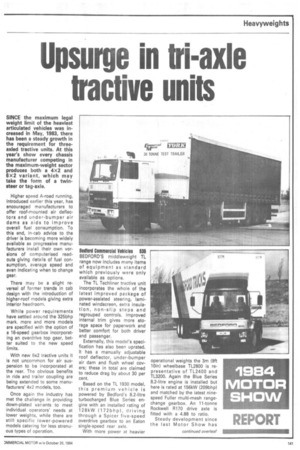
Page 144
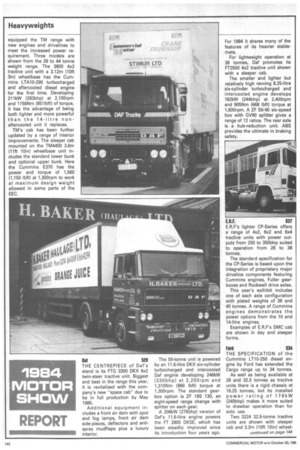
Page 146
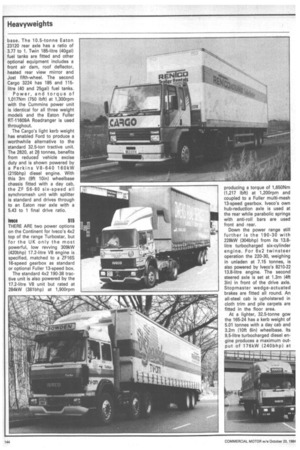
Page 147
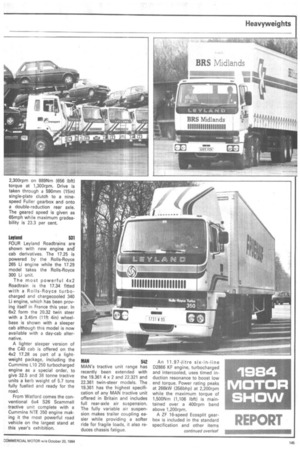
Page 148
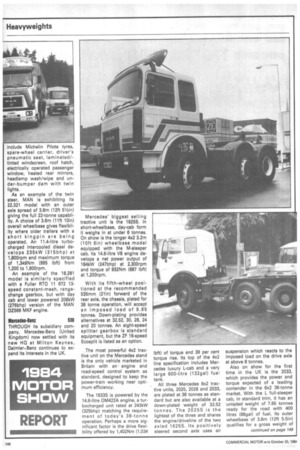
Page 151
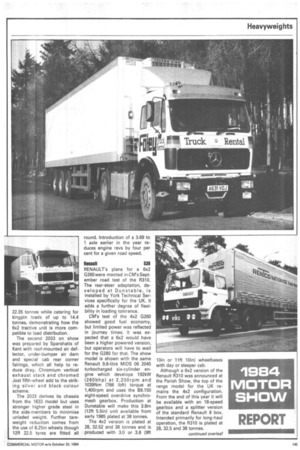
Page 152

Page 153
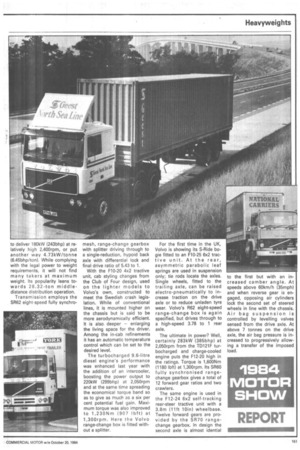
If you've noticed an error in this article please click here to report it so we can fix it.
SINCE the maximum legal weight limit of the heaviest articulated vehicles was increased in May, 1983, there has been a steady growth in the requirement for threeaxled tractive units. At this year's show every chassis manufacturer competing in the maximum-weight sector produces both a 4X2 and 6X2 variant, which may take the form of a twinsteer or tag-axle.
Higher speed A-road running, Introduced earlier this year, has encouraged manufacturers to offer roof-mounted air deflectors and under-bumper air dams as aids to improve overall fuel consumption. To this end, In-cab advice to the driver Is becoming more widely
available as progressive menufacturers install their own ver
sions of computerised readouts giving details of fuel consumption, average speed and even indicating when to change gear.
There may be a slight reversal of former trends In cab design with the introduction of higher-roof models giving extra interior headroom.
While power requirements have settled around the 325bho mark, more and more models are specified with the option of a 16-speed gearbox incorporating an overdrive top gear, better suited to the new speed limits.
With new 6x2 tractive units it is not uncommon for air suspension to be incorporated at the rear. The obvious benefits in ride and trailer coupling are being extended to some manufacturers' 4x2 models, too.
Once again the industry has met the challenge in providing down-plated variants to meet individual operators' needs at lower weights, while there are still specific lower-powered models catering for less strenuous types of operation.
Bedford Commercial Vehicles IN BEDFORD'S middleweight TL range now includes many Items of equipment as standard which previously were only available as options.
The TL Techliner tractive unit incorporates the whole of the latest improved package of power-assisted steering, laminated windscreen, extra insulation, non-slip steps and regrouped controls. Improved internal trim gives more storage space for paperwork and better comfort for both driver and passenger.
Externally, this model's specification has also been uprated. It has a manually adjustable roof deflector, under-bumper air dam and flush wheel covers; these in total are claimed to reduce drag by about 30 per cent.
Based on the TL 1930 model, this premium vehicle is powered by Bedford's 8.2-litre turbocharged Blue Series engine with an installed rating of 1 2 8kW (1 7 2bhp), driving through a Spicer five-speed overdrive gearbox to an Eaton single-speed rear axle.
With more power at heavier operational weights the 3m (9ft 10in) wheelbase TL2800 is representative of TL2400 and TL3200. Again the Blue Series 8.2-litre engine is installed but here is rated at 156kW (209bhp) and matched by the latest ninespeed Fuller multi-mesh rangechange gearbox. An 11-tonne Rockwell R170 drive axle is fitted with a 4.88 to ratio.
Steady development since the last Motor Show has equipped the TM range with new engines and drivelines to meet the increased power requirement. Three models are shown from the 28 to 44 tonne weight range. The 3800 4x2 tractive unit with a 3.12m (loft 3in) wheelbase has the Cummins LTA10-290 turbocharged and aftercooled diesel engine for the first time. Developing 211kW (283bhp) at 2,100rpm and 1156Nm (8511bft) of torque, it has the advantage of being both lighter and more powerful than the 14-litre nonaftercooled unit it replaces.
TM's cab has been further updated by a range of interior improvements. The sleeper cab mounted on the TM4400 3.6m (lift 10in) wheelbase unit includes the standard lower bunk and optional upper bunk. Here the Cummins E370 has the power and torque of 1,560 (1,150 lbft) at 1,300rpm to work at maximum design weight allowed in some parts of the EEC.
Oaf 529
THE CENTREPIECE of Daf's stand is its FTG 3300 DKX 6x2 twin-steer tractive unit. Biggest and best in the range this year, it is revitalised with the company's new "space cab" due to be in full production by May 1985.
Additional equipment includes a front air dam with spot and fog lamps, front air dam side-pieces, deflectors and antispray mudflaps plus a luxury interior. The 55-tonne unit is powered by an 11.6-litre DKX six-cylinder turbocharged and intercooled Daf engine developing 246kW (330bhp) at 2,200rpm and 1,310Nm (966 lbft) torque at 1,300rpm. The standard gearbox option is ZF 16S 130, an eight-speed range change with splitter on each gear.
A 206kW (276bhp) version of Oaf's 11.6-litre engine powers the FT 2800 DKSE, which has been steadily improved since its introduction four years ago. For 1984 it shares many of the features of its heavier stablemate.
For lightweight operation at 38 tonnes, Daf promotes its FT2500 4x2 tractive unit shown with a sleeper cab.
The smaller and lighter but relatively high revving 8.25-litre six-cylinder turbocharged and intercooled engine develops 182kW (244bhp) at 2,400rpm and 905Nrn (668 lbft) torque at 1,600rpm. A ZF S6-90 six-speed box with GV90 splitter gives a range of 12 ratios. The rear axle is a hub-reduction unit. ABS provides the ultimate in braking safety.
E.R.F. 537
E.R.F's lighter CP-Series offers a range of 4x2, 6x2 and 6x4 tractive units with power outputs from 250 to 350bhp suited to operation from 28 to 38 tonnes.
The standard specification for the CP-Series is based upon the integration of proprietary major driveline components featuring Cummins engines, Fuller gearboxes and Rockwell drive axles.
This year's exihibit includes one of each axle configuration with plated weights of 38 and 40 tonnes. A range of Cummins engines demonstrates the power options from the 10 and 14-litre engines.
Examples of E.R.F's SMC cab are shown in day and sleeper forms.
Ford 534
THE SPECIFICATION of the Cummins LT10-250 diesel engine by Ford has extended the Cargo range up to 34 tonnes.
As well as being available at 28 and 32.5 tonnes as tractive units there is a rigid chassis at 16.25 tonnes, but its installed power rating of 179kW (240bhp) makes it more suited to drawbar operation than for solo use.
Two 3224 32.5-tonne tractive units are shown with sleeper cab and 3.3m (10ft 10in) wheelcontinued on page 144 base. The 10.5-tonne Eaton 23120 rear axle has a ratio of 3.77 to 1. Twin 185-litre (40gal) fuel tanks are fitted and other optional equipment includes a front air dam, roof deflector, heated rear view mirror and Jost fifth-wheel. The second Cargo 3224 has 185 and 115litre (40 and 25ga1) fuel tanks.
• Power, and torque of 1,017Nrn (750 lbft) at 1,300rpm with the Cummins power unit is identical for all three weight model's and the Eaton Fuller RT-11609A Roadranger is used throughout.
The Cargo's light kerb weight has enabled Ford to produce a worthwhile alternative to the standard 32.5-ton tractive unit. The 2820, at 28 tonnes, benefits from reduced vehicle excise duty and is shown powered by a Perkins V8-640 160kW (215bhp) diesel engine. With this 3m (9ft 10in) wheelbase chassis fitted with a day cab, the ZF S6-80 six-speed all synchromesh unit with splitter is standard and drives through to an Eaton rear axle with a 5.43 to 1 final drive ratio.
hreco 515 THERE ARE two power options on the Continent for lveco's 4x2 top of the range Turbostar, but for the UK only the most powerful, low revving 309kW (420bhp) 17,2-litre V8 engine is specified, matched to a ZF16S 16-speed gearbox as standard or optional Fuller 13-speed box.
The standard 4x2 190-38 tractive unit is also powered by the 17.2-litre V8 unit but rated at 284kW (381bhp) at 1,900rpm producing a torque of 1,650Nm (1,217 lbft) at 1,200rpm and coupled to a Fuller multi-mesh 13-speed gearbox. Iveco's own hub-reduction axle is used at the rear while parabolic springs with anti-roll bars are used front and rear.
Down the power range still further is the 190-30 with 228kW (304bhp) from its 13.8litre turbocharged six-cylinder engine. For 6x2 twinsteer operation the 220-30, weighing in unladen at 7.15 tonnes, is also powered by iveco's 8210-22 13.8-litre engine. The second steered axle is set at 1.3m (4ft 3in) in front of the drive axle. Stopmaster wedge-actuated brakes are fitted all round. An all-steel cab is upholstered in cloth trim and pile carpets are fitted in the floor area.
At a lighter, 32.5-tonne gcw the 165-24 has a kerb weight of 5.01 tonnes with a day cab and 3.2m (10ft 6in) wheelbase. Its 9.5-litre turbocharged diesel engine produces a maximum output of 176kW (240bhp) at 2,300rpm on 889Nm (656 lbft) torque at 1,300rpm. Drive is taken through a 590mm (151n) single-plate clutch to a ninespeed Fuller gearbox and onto a double-reduction rear axle. The geared speed is given as 65mph while maximum gradeability is 23.3 per cent.
Leyland 531
FOUR Leyland Roadtrains are shown with new engine and cab derivatives. The 17.25 is powered by the Rolls-Royce 265 Li engine while the 17.29 model takes the Rolls-Royce 300 Li unit.
The most powerful 4x2 Roadtrain is the 17.34 fitted with a Rolls-Royce turbocharged and chargecooled 340 Li engine, which has been proving itself in France this year. In 6x2 form the 20.32 twin steer with a 3.45m (lift 4in) wheelbase is shown with a sleeper cab although this model is now available with a day-cab alternative.
A lighter sleeper version of the C40 cab is offered on the 4x2 17.28 as part of a lightweight package, including the Cummins L10 250 turbocharged engine as a special order, to give 32.5 and 38 tonne tractive units a kerb weight of 5.7 tons fully fuelled and ready for the road.
From Watford comes the conventional 6x4 S26 Scammell tractive unit complete with a Cummins NTE 350 engine making it the most powerful road vehicle on the largest stand at this year's exhibition.
MAN
542 MAN's tractive unit range has recently been extended with the 19.361 4 x 2 and 22.321 and 22.361 twin-steer models. The 19.361 has the highest specification of any MAN tractive unit offered in Britain and includes full rear-axle air suspension. The fully variable air suspension makes trailer coupling easier while providing a softer ride for fragile loads, it also reduces chassis fatigue. An 11.97-rnre six-in-line D2866 KF engine, turbocharged and intercooled, uses timed induction resonance to boost low end torque. Power rating peaks at 266kW (356bhp) at 2,200rpm while the maximum torque of 1,500Nm (1,106 bft) is maintained over a 400rpm band above 1,200rpm.
A ZF 16-speed Ecosplit gearbox is included in the standard specification and other items include Michelin Pilote tyres, spare-wheel carrier, driver's pneumatic seat, laminated/tinted windscreen, roof hatch, electrically operated passenger window, heated rear mirrors, headlamp wash/wipe and under-bumper dam with twin lights.
As an example of the twin steer, MAN is exhibiting its 22,321 model with an outer axle spread of 3.8m (12ft 51/2in) giving the full 22-tonne capabilIty, A choice of 3,6m (lift 10in) overall wheelbase gives flexibility where older trailers with a short kingpin are being operated. An 11.4-litre turbocharged intercooled diesel develops 235kW (315bhp) at 1,800rpm end maximum torque of 1,349Nrn (995 lbft) from 1,200 to 1,600rpm.
An example of the 16.281 model Is similarly specified with a Fuller RTO 11 672 13speed constant-mesh, rangechange gearbox, but with day cab and lower powered 206kW (276bhp) version of the MAN DZ566 MKF engine, Mercedes-Benz 530
THROUGH its subsidiary company, Mercedes-Benz (United Kingdom) now settled with its new HQ at Milton Keynes, Daimler-Benz continues to expand its interests in the UK.
Mercedes' biggest selling tractive unit is the 16255. In short-wheelbase, day-cab form It weighs in at under 6 tonnes, On show Is the longer 4x2 3.2m (10ft 61n) wheelbase model equipped with the M-sleeper cab. Its 14.6-litre 1/8 engine develops a net power output of 184kW (247bhp) at 2,300rpm arid torque of 932Nm (687 lbft) at 1,200rpm.
With its fifth-wheel positioned at the recommended 535rnm (21In) forward of the rear axle, the chassis, plated for 38 tonne operation, will accept an imposed load of 9,95 tonnes. Down-plating provides alternatives at 32.52, 30, 28, 24 and 20 tonnes. An eight-speed splitter gearbox is standard equipment, but the ZF 16-speed Ecosplit is listed as an option.
The most powerful 4x2 tractive unit on the Mercedes stand is the only vehicle marketed in Britain with an engine and road-speed control system as standard, designed to keep the power-train working near optimum efficiency.
The 1633S is powered by the 14.6-litre 0M422A engine, a turbocharged unit rated at 243kW (325bhp) matching the requirement of today's 38-tonne operation. Perhaps a more significant factor is the drive flexibility offered by 1,402Nm (1,034
lbft) of torque and 39 per cent torque rise. Its top of the 4x2 line specification includes Mercedes luxury L-cab and a very large 600-litre (132ga1) fuel tank.
All three Mercedes 6x2 tractive units, 2025, 2028 and 2033, are plated at 38 tonnes as standard but are also available at a down-plated weight of 32.52 tonnes. The 2 02 5S is the lightest of the three and shares the engine/driveline of the two axled 1625S. Its positively steered second axle uses air
suspension which reacts to the imposed load on the drive axle at above 8 tonnes.
Also on show for the first time in the UK is the 2033, which provides the power and torque expected of a leading contender in the 6x2 38-tonne market. With the L full-sleeper cab, in standard trim, it has an unladed weight of 7.65 tonnes, ready for the road with 400 litres (88gal) of fuel. Its outer wheelbase of 3.8m (12ft 5.5in) qualifies for a gross weight of
22.35 tonnes while catering for kingpin loads of up to 14.4 tonnes, demonstrating how the 6x2 tractive unit is more compatible to load distribution.
The second 2033 on show was prepared by Sparshatts of Kent with roof-mounted air deflector, under-bumper air dam and special cab rear corner fairings, which all help to reduce drag. Chromium vertical exhaust stack and chromed Jost fifth-wheel add to the striking silver and black colour scheme.
The 2033 derives its chassis from the 1633 model but uses stronger higher grade steel in the side-members to minimise unladed weight. Further tareweight reduction comes from the use of 8.25in wheels though 12R 22.5 tyres are fitted all
Renault 538
RENAULT's plans for a 6x2 G260 were mooted in CM'sSeptember road test of the R310. The rear-steer adaptation, developed at Dunstable, is installed by York Technical Services specifically for the UK. It adds a further degree of flexibility in loading tolerance, CM's test of the 4x2 G260 showed good fuel economy, but limited power was reflected in journey times. It was expected that a 6x2 would have been a higher powered version, but operators will have to wait for the G280 for that. The show model is shown with the same Renault 9.8-litre MIDS 06 2045 turbocharged six-cylinder engine which develops 192kW (2 60bhp) at 2,200rpm and 1039Nm (766 Ibft) torque at 1,400rpm and uses the B9.150 eight-speed overdrive synchromesh gearbox. Production at Dunstable will make this 3.8m (12ft 5.5in) unit available from early 1985 plated at 38 tonnes.
The 4x2 version is plated at 28, 32.52 and 38 tonnes and is produced with 3.0 or 3.6 (9ft 10in or 11ft 10in) wheelbases with day or sleeper cab.
Although a 6x2 version of the Renault R310 was announced at the Parish Show, the top of the range model for the UK remains the 4x2 configuration. From the end of this year it will be available with an 18-speed gearbox and a splitter version of the standard Renault 9 box. Intended primarily for long-haul operation, the R310 is plated at 28, 32.5 and 38 tonnes. Scanla 543 FIVE TRACTIVE UNITS exhibit Scania's range with which the company has grown strongly this year reaching a 17 per cent share of the over 16-tonne sector in August.
With the 92-Series, announced in CM September 29, a range based around a new 8.5-litre diesel engine in both turbocharged and intercooled form, Scania (latin for Griffin) adds more feathers to its plumage.
At 38 tonnes gcw, the P92MA 4x2 tractive unit is shown with the turbocharged and air to air intercooled DCS9 unit giving an output of 202kW 1275bhp) at 2,200rpm and torque of 1,097Nm (809 lbft) at 1,200rpm. This engine is quite different from other Scania engines, being constructed with separate cylinder heads for each of the six cylinders and with the Bosch fuel pump mounted on the cool side of the block. A sleeper cab, alloy wheels, 10speed splitter gearbox and 3.78 to 1 rear axle complete the specification.
The non-intercooled DS9 engine rated at 180kW (245bhp) is fitted to a P92M 4x2 day-cab tractive unit. This model has the Scania G5771 10-speed splitter gearbox and slow 4.25 to 1 rear axle.
Moving up in power, the P1 12M 6x2 has a design weight of 48 tonnes. The version on display is fitted with the lowestmounted (P) sleeper cab and powered by an 11-litre 228kW (305bhp) engine. Drive is taken via a 10-speed range-change box to the second axle. The third trailing axle can be lifted when running with a light load.
With intercooler, the 11-litre engine produces 248kW (333bhp) and is shown on an R112MA 4x2 chassis fitted with the largest (R) double-sleeper cab. This vehicle has a design weight of 52 tonnes.
Scania's R142MA 4x2 tractive unit displayed with a V8 intercooled engine has the same design weight. Despite its huge power of 313kW (420bhp) the manufacturer says it is one of the most economical tractive units available in the UK.
Seddon Atkinson 533 SEDDON ATKINSON, which has introduced a succession of new models over the past two years, has yet one more for this year's Motor Show.
The T17 G32, for operation at 38 tonnes, is an addition to the 401 range of premium tractive units, powered by the new Gardner 6LYT engine,to give an installed power output of 229kW (307bhp) at a low revving 1,800rpm. Maximum torque at 1,365rpm (1,007 lbft) is attained at 1,200rpm. The engine is matched to a 13-speed RTX 11613 Eaton Fuller gearbox driving through to a Rockwell S180E axle.
Shown as a prototype earlier in the year, the T24 R30 6x4 401 tractive unit is now presented as a production vehicle.
Its Rolls-Royce Eagle 300 Li diesel develops 215kW (288bhp) at 1,095rpm and 1,242Nm (916 bft) torque at 1,200rpm. The nine-speed gearbox here is also supplied by Eaton Fuller, but Seddon Atkinson's own double-drive RA472 bogie is installed at the rear with Norde rubber suspension.
Seddon Atkinson's T22 L29 6x2 sleeper cabbed 301 on the stand weighs in at 6.37 tonnes and is said to be the lightest in Europe with this axle configuration for operation at 38 tonnes. Using the 301 chassis, a Cummins LTA 10-290 diesel engine rated at 208kW (278bhp) and 1,150Nm (848 lbft) torque and a 10-speed SST 1310-4A Spicer gearbox all contribute to the vehicle's low kerb weight.
Volvo 516 ONCE AGAIN, Volvo demonstrates its strength in the 28 tonnes and above sector with an impressive range of six differently specified tractive units.
Plated at 28 tonnes, the F6165 4x2 tractive unit has a wheelbase of 3.2m (10ft 6in) Its Volvo TD6OB turbocharged 5.48-litre engine rated at 131kW (178bhp) at 2,800rpm, giving a maximum torque output of 530Nm (390 lbft) at 1,900rpm, gave a fuel consumption figure of 29.09 lit/100km (9.71mpg) on test with CM earlier this year at 24 tons gvw.
Volvo's R52 range-change gearbox has eight ratios with full synchromesh gearing. The RAE 1808 single-reduction hypoid axle incorporating difflock and final drive ratio of 5.43 to 1 is standard across the F6 range.
Volvo's F7-20 4x2 tractive unit has a wheelbase of 3.4m (lift 2in) and, with tongue in cheek, is plated for operation at 38 tonnes. Its TD 70FS 6.7-litre engine has the benefit of turbocharging and charge air-cooling to deliver 180kW (243bhp) at relatively high 2,400rpm, or put another way 4.73kW/tonne (6.45bhpiton), While complying with the legal power to weight requirements, it will not find many takers at maximum weight. Its popularity leans towards 28.32-ton middledistance distribution operation.
Transmission employs the SR62 eight-speed fully synchro
mesh, range-change gearbox with splitter driving through to a single-reduction, hypoid back axle With differential lock and final drive ratio of 5.43 to 1.
With the F10-20 4x2 tractive unit, cab styling changes from the Club of Four design, used on the lighter models to Volvo's own, constructed to meet the Swedish crash legislation. While of conventional lines, it is mounted higher on the chassis but is said to be more aerodynamically efficient. It is also. deeper — enlarging the living space for the driver. Among the in-cab refinements it has an automatic temperature control which can be set to the desired level.
The turbocharged 9.6-litre diesel engine's performance was enhanced last year with the addition of an intercooler, boosting the power output to 220kW (299bhp) at 2,050rpm and at the same time spreading the economical torque band so as to give as much as a six per cent potential fuel gain. Maximum torque was also improved to 1,230Nm (907 lbft) at 1,300rpm. Here the Volvo range-change box is fitted without a splitter. For the first time in the UK, Volvo is showing its S-Ride bogie fitted to an F10-25 6x2 tractive unit. At the rear, asymmetric parabolic leaf springs are used in suspension only; tie rods locate the axles. Single wheels, fitted to the trailing axle, can be raised electro-pneumatically to increase traction on the drive axle or to reduce unladen tyre wear. Volvo's R62 eight-speed range-change box is again specified, but drives through to a high-speed 3.78 to 1 rear axle.
The ultimate in power? Well, certainly 283kW (385bhp) at 2,050rpm from the TD121F turbocharged and charge-cooled engine puts the 112-20 high in the ratings. Torque is 1,600Nm (1180 Ibft) at 1,300rpm. Its SR60 fully synchronised rangechange gearbox gives a total of 12 forward gear ratios and two crawlers.
The same engine is used in the F12-24 6x2 self-tracking rear-steer tractive unit with a 3.8m (lift 10in) wheelbase. Twelve forward gears are provided by the SR70 rangechange gearbox. In design the second axle is almost idential to the first but with an increased camber angle. At speeds above 60km/h (35mph) and when reverse gear is engaged, opposing air cylinders lock the second set of steered wheels in line with the chassis. Air bag suspension is controlled by levelling valves sensed from the drive axle. At above 7 tonnes on the drive axle, the air bag pressure is increased to progressively allowing a transfer of the imposed load.
































































































































































































































